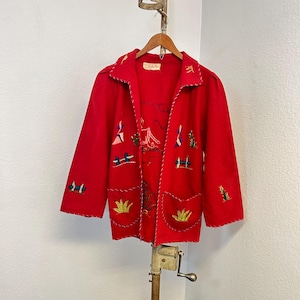
A few years ago, Emery took me to a vintage store in a nearby town that had become one of her favorites. She had been talking about it for months, but finding free time with her busy schedule wasn’t easy. She had purchased several pieces there, including clothing, her dining room chairs and some art. She told me I’d not only love the merchandise but also the store’s unique western decor, as well as the owner, whom she now knew on a first-name basis. She was right on all counts. As soon as I walked in the heavy wooden front door of the store, which sat on a corner and was once a filling station, I felt right at home. The decor in the shop matched my own decor, both the decor I own and the decor I want to own.
Emery immediately spotted a vintage Mexican tourist jacket, insisted it was “me,” and told me I needed to try it on. It was expensive, but Emery told me jackets like that were rare, especially in pristine condition. Given its uniqueness, she thought it was well-priced. Emery has talked me into buying more than one item, both clothing and otherwise, that I was reluctant to purchase because it was too expensive. But she was rarely wrong, and every piece I shared the excitement of the purchase with her has turned out to be a treasure. Swept up in her enthusiasm, I tried the jacket on. The store owner, Susan, told us it had been a rare find and she debated keeping it for herself — words that made me start justifying the price tag in my head, given Susan’s enviable style. I hung it back up and continued to shop, telling myself I needed to think about it, but knowing full well it would be going home with me.
As I made my way around the shop, weaving in and out of furniture, home decor, and clothing, a gray knitted vest that I guessed was from the 1940s caught my eye. Unfortunately, it had caught the eye of another shopper, who picked it up as I was nearing the rack, holding it up to check the size. I moved on, continuing my way around the handful of clothing racks, eventually making a full circle and returning to the gray vest, which had once again been returned to the rack. I took it to the dressing room to try on, and, of course, it fit perfectly and was priced well. Without hesitation, I took the vest to the counter and set it down, knowing it was a sure thing, but I still needed some more thinking time, or persuasion from Emery, on the jacket.
Now, if you’re still reading this and thinking, “Ok, so what?” Hold on. There’s more.
Emery continued with her persuasion, reminding me that it was so me and such a rare find, so I set it down next to the vest to buy them both.
The woman who had held up the vest previously asked,
“Did you put this here? Because I was going to buy it.”
“Yes, I did.” I figured that would clear up her confusion, although at the same time, I was beginning to feel defensive.
“But it’s mine and I am going to buy it,” she responded.
“Yours? But it was on the rack. You returned it.”
“But I was going to go back and get it, so it’s mine.”
Now I was definitely feeling defensive.
“I put it on the counter, which to me indicates that I was going to purchase it,” I said, my pulse now racing.
“But you saw me holding it up.”
“But you returned it.”
The conversation went back and forth, with both of us claiming the vest was ours to purchase, with little movement on either side. Then something shifted. I saw Emery and the store owner watching our back-and-forth and realized that, as Emery’s mom, I wanted to set a good example. Had she not been there, I would have held my ground, and things may have gotten ugly, but I would have gone home with the vest. Instead, I was the bigger person and said, “Ok, the vest is yours.”
I gestured for her to go ahead of me, and she thanked me, made her purchase, and headed for the door. Before leaving, though, she turned around and, with grace and kindness, said, “That was really nice of you, and I appreciate what you just did. Really.” And then she left. She wanted that vest, and maybe even more because I was in the process of buying it, but in that moment, it didn’t matter. I had done the right thing, or so I thought. I had set a good example in front of my daughter and the store owner, who watched the entire drama unfold. Or so I thought. After the woman left the store, leaving only the store owner, Susan, Emery, and me, Emery told me I had done a nice thing for the woman, as she looked like she was suffering. After the woman left the store and only the store owner, Susan, Emery and I remained, Emery told me it was nice what I had done for the woman as she looked like she was suffering.
“Suffering?” I asked. “Well, maybe. She looked sad. Maybe she had had a fight with her boyfriend or husband, or maybe she had just lost her job or learned her mom had cancer. She looked sad. And now she has the vest she wanted, and she seemed a little happier when she left.” My first thought was that Emery saw far deeper into the woman’s emotional state than I had. As much as I liked the vintage vest, I had done the right thing, or so I thought.
“But… I can’t believe you let her buy it, Mom. I mean, it looked so cute on you, and you had it on the counter. Everyone knows that means you’re getting ready to purchase it.”
Had this been a moment of kindness I had demonstrated for Emery’s benefit, or a display of weakness?
The store owner, Susan, chimed in.
“Yes, that was nice what you did, but clearly it was your vest.”
A few minutes later, another customer came into the store, and the store owner, whom I now also know well enough to call Susan, asked her opinion on the matter.
“Do you think that putting something on the counter by the register means you’re going to buy it?”
The woman agreed wholeheartedly with Susan (and Emery). Then, the store owner filled in the details, explaining how kind I had been by letting the woman have the vest that I had clearly claimed. Now I’m the nice, albeit pushover customer, or so it seemed. Susan said she felt bad and was going to look for similar vests on her upcoming shopping trips, and for some reason, I knew she wasn’t just saying that to placate me.
I was happy with my jacket purchase because I loved it, but I was still struggling to let go of what had happened. I wished I had been more assertive. I wanted the vest.
But there’s more…
When reviewing my credit card statement a few weeks later, I noticed a large charge from a gas station—a charge I hadn’t made. I had recently driven to KC and back and assumed the fraud had happened somewhere in western Kansas while I was getting gas, although the dates didn’t quite align. Having gone through credit card fraud a few times, I knew the drill. I called my credit card company and reported that my card appeared to have been compromised at a gas station. They credited the charge and told me a new card would arrive within a few days. A few hours later, while stopped at a stoplight, it dawned on me what the charge was for. The boutique where I had bought the vintage jacket was located in what had been a filling station, which is why the charge listed the filling station’s name instead of the boutique’s. I knew I was right as the amount was exactly what I had paid for the jacket. I called the credit card company back. First, I wanted to ensure that the merchant had been paid. Then, I asked if the charge could be put back on my card, a request they told me they had never run across before. They told me they couldn’t do that as that account had been closed. “Consider it a gift,” the woman told me. Or maybe karma, I thought.
But there’s more…
A few months later, Emery came over with a gift bag and handed it to me, explaining it was from Susan, who owned the shop where the drama had occurred. Inside was a gray vintage sweater vest, similar to the vest I had given up. She told me Susan wanted me to know it was her gift to me. I was deeply touched that she had remembered and followed through on her promise. I’m usually good with my thank-you’s, but for some reason, my plans to write her a thank-you note were forgotten. I went to the boutique a few times afterwards to thank her in person, but she was never there.
The next time I saw Susan was at Emery’s celebration of life, a day that I’ve forgotten more about than I’ve remembered. I remember her approaching me and hugging me with tears flowing down her cheeks, and the only thing I could think to say to her was, “I’m so sorry…I forgot to thank you for the sweater.”
She nodded, and of course, she understood.
